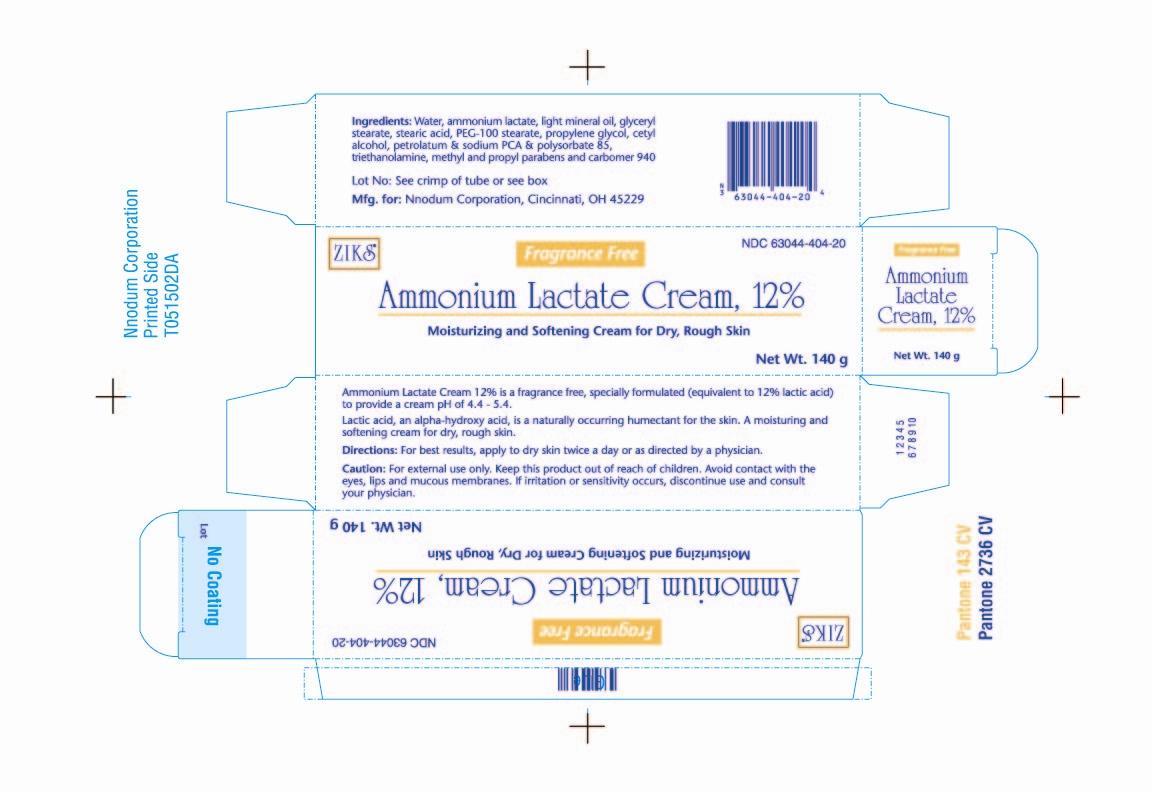DESCRIPTION
Ammonium Lactate Cream, 12% is a formulation of 12% lactic acid neutralized with ammonium hydroxide, as ammonium lactate with a pH of 4.4-5.4.
Ingredients: Ammonium Lactate Cream, 12% also contains cetyl alcohol, glycerin, glyceryl stearate, light mineral oil, magnesium aluminum silicate, methyl and propyl parabens, Carbomer 940, PEG-100 stearate, polysorbate 85, triethanolamine, propylene glycol, Petrolatum and Sodium PCA, stearic acid and water.
Lactic acid is a racemic mixture of 2-hydroxypropanoic acid and has the following structural formula:

CLINICAL PHARMACOLOGY
Lactic acid is an alpha-hydroxy acid. It is a normal constituent of tissues and blood. The alpha-hydroxy acids (and their salts) may act as humectants when applied to the skin. This property may influence hydration of the stratum corneum. In addition, lactic acid, when applied to the skin, may act to decrease corneocyte cohesion. The mechanism(s) by which this is accomplished is not yet known.
An in vitro study of percutaneous absorption of Ammonium Lactate Cream using human cadaver skin indicates that approximately 5.8% of the material was absorbed after 68 hours.
INDICATIONS AND USAGE
Ammonium Lactate Cream is indicated for the treatment of dry, scaly skin (xerosis) and ichthyosis vulgaris and for temporary relief of itching associated with these conditions.
CONTRAINDICATIONS
Ammonium Lactate Cream is contraindicated in those patients with a history of hypersensitivity to any of the label ingredients.
WARNING
Sun exposure to areas of the skin treated with Ammonium lactate Cream, 12% should be minimized or avoided (see PRECAUTIONS). The use of Ammonium Lactate Cream should be discontinued if any hypersensitivity is observed.
PRECAUTIONS
General
For external use only. Stinging or burning may occur when applied to skin with fissures, erosions, or that is otherwise abraded (for example, after shaving the legs). Caution is advised when used on the face because of the potential for irritation. The potential for post-inflammatory hypo- or hyperpigmentation has not been studied.
Information For Patients
Patients using Ammonium lactate Cream, 12% should receive the following information and instructions:
1).This medication is to be used as directed by the physician, and should not be used for any disorder other than for which it was prescribed. It is for external use only. Avoid contact with eyes, lips, or mucous membranes.
2).Patients should minimize or avoid use of this product on areas of the skin that may be exposed to natural or artificial sunlight, including the face. If sun exposure is unavoidable, clothing should be worn to protect the skin.
3).This medication may cause transient stinging or burning when applied to skin with fissures, erosions, or abrasions (for example, after shaving the legs).
4).If the skin condition worsens with treatment, the medication should be promptly discontinued
Carcinogenesis, Mutagenesis, Impairment of Fertility
The topical treatment of CD-1 mice with 12%, 21% or 30% ammonium lactate formulations for two years did not produce a significant increase in dermal or systemic tumors in the absence of increased exposure to ultraviolet radiation. The maximum systemic exposure of the mice in this study was 0.7 times the maximum possible systemic exposure in humans. However, a long-term photocarcinogenicity study in hairless albino mice suggested that topically applied 12% ammonium lactate formulations enhanced the rate of ultraviolet light-induced skin tumor formation.
The mutagenic potential of ammonium lactate formulations was evaluated in the Ames assay and in the mouse in vivo micronucleus assay, both of which were negative.
In dermal Segment I and III studies with ammonium lactate formulations there were no effects observed in fertility or pre- or post-natal development parameters in rats at dose levels of 300 mg/kg/day (1800 mg/m2/day), approximately 0.4 times the human topical dose.
Pregnancy
Teratogenic Effects :Pregnancy Category B.
Animal reproduction studies have been performed in rats and rabbits at doses up to 0.7 and 1.5 times the human dose, respectively (600 mg/kg/day, corresponding to 3600 mg/m2/day in the rat and 7200 mg/m2/day in the rabbit) and have revealed no evidence of impaired fertility or harm to the fetus due to ammonium lactate formulations. There are, however, no adequate and well-controlled studies in pregnant women. Because animal reproduction studies are not always predictive of human response, Ammonium Lactate Cream should be used during pregnancy only if clearly needed.
Nursing Mothers
Although lactic acid is a normal constituent of blood and tissues, it is not known to what extent this drug affects normal lactic acid levels in human milk. Because many drugs are excreted in human milk, caution should be exercised when Ammonium Lactate Cream is administered to a nursing woman.
Pediatric Use
Safety and effectiveness of Ammonium Lactate Cream have been demonstrated in infants and children. No unusual toxic effects were reported.
Geriatric Use
Clinical studies of Ammonium lactate Cream, 12% did not include sufficient numbers of subjects aged 65 and over to determine whether they respond differently from younger subjects. Other reported clinical experience has not identified differences in responses between elderly and younger patients. In general, dose selection for an elderly patient should be cautious.
ADVERSE REACTIONS
The most frequent adverse experiences in patients with xeroxis are transient stinging (1 in 30 patients), burning (1 in 30 patients), erythema (1 in 50 patients) and peeling (1 in 60 patients). Other adverse reactions which occur less frequently are irritation, eczema, petechiae, dryness and hyperpigmentation.
Due to more severe initial skin conditions associated with ichthyosis, there was a higher incidence of transient stinging, burning and erythema (each occurring in 1 in 10 patients).
OVERDOSAGE
The oral administration of Ammonium Lactate Cream to rats and mice showed this drug to be practically non-toxic (LD50 > 15 mL/kg).
DOSAGE AND ADMINISTRATION
Shake well. Apply to the affected areas and rub in thoroughly. Use twice daily or as directed by a physician.
HOW SUPPLIED
Ammonium lactate Cream, 12% is available in a 140g (NDC # 63044-404-20) plastic tube.
Store at controlled room temperature 15° C - 30° C (59° F - 86° F).
Manufactured for:
Nnodum Pharmaceuticals
Cincinnati, Ohio 45229
By: EMS Contract Manufacturing
Revised January 2008
Ammonium lactate Lotion
